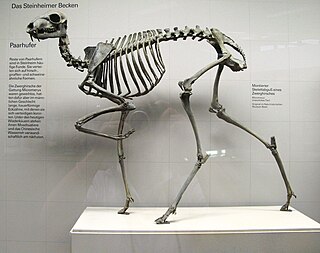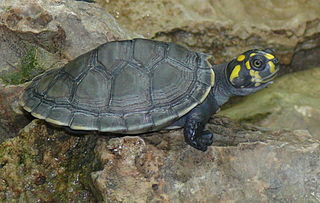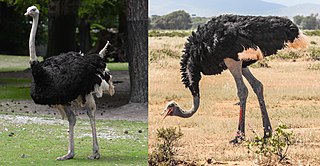
Hyenas or hyaenas, are feliform carnivoran mammals belonging to the family Hyaenidae. With just four extant species, it is the fifth-smallest family in the Carnivora and one of the smallest in the class Mammalia. Despite their low diversity, hyenas are unique and vital components of most African ecosystems.
The Miocene is the first geological epoch of the Neogene Period and extends from about 23.03 to 5.333 million years ago (Ma). The Miocene was named by Scottish geologist Charles Lyell; the name comes from the Greek words μείων and καινός and means "less recent" because it has 18% fewer modern marine invertebrates than the Pliocene has. The Miocene is preceded by the Oligocene and is followed by the Pliocene.

A pika is a small, mountain-dwelling mammal native to Asia and North America. With short limbs, a very round body, an even coat of fur, and no external tail, they resemble their close relative, the rabbit, but with short, rounded ears. The large-eared pika of the Himalayas and nearby mountains lives at elevations of more than 6,000 m (20,000 ft).

The Anatidae are the biological family of water birds that includes ducks, geese, and swans. The family has a cosmopolitan distribution, occurring on all the world's continents except Antarctica. These birds are adapted for swimming, floating on the water surface, and in some cases diving in at least shallow water. The family contains around 174 species in 43 genera.

Moschidae is a family of pecoran even-toed ungulates, containing the musk deer (Moschus) and its extinct relatives. They are characterized by long 'saber teeth' instead of horns, antlers or ossicones, modest size and a lack of facial glands. While various Oligocene and Miocene pecorans were previously assigned to this family, recent studies find that most should be assigned to their own clades, although further research would need to confirm these traits. As a result, Micromeryx, Hispanomeryx, and Moschus are the only undisputed moschid members, making them known from at least 18 Ma. The group was abundant across Eurasia and North America during the Miocene, but afterwards declined to only the extant genus Moschus by the early Pleistocene.

Podocnemididae is a family of pleurodire (side-necked) turtles, once widely distributed. Most of its 20 genera and 30 species are now extinct. Seven of its eight surviving species are native to South America: the genus Peltocephalus, with only one species ; and the genus Podocnemis, with six living species of South American side-necked river turtles. There is also one genus native to Madagascar: Erymnochelys, the Madagascan big-headed turtle, whose single species E. madagascariensis.

The Lacertidae are the family of the wall lizards, true lizards, or sometimes simply lacertas, which are native to Afro-Eurasia. It is a diverse family with at about 360 species in 39 genera. They represent the dominant group of reptiles found in Europe.

Ostriches are large flightless birds. They are the heaviest and largest living birds, with adult common ostriches weighing anywhere between 140-320 lbs and laying the largest eggs of any living land animal. With the ability to run at 70 km/h (43.5 mph), they are the fastest birds on land. They are farmed worldwide, with significant industries in the Philippines and in Namibia. Ostrich leather is a lucrative commodity, and the large feathers are used as plumes for the decoration of ceremonial headgear. Ostrich eggs have been used by humans for millennia.

Dryopithecus is a genus of extinct great apes from the middle–late Miocene boundary of Europe 12.5 to 11.1 million years ago (mya). Since its discovery in 1856, the genus has been subject to taxonomic turmoil, with numerous new species being described from single remains based on minute differences amongst each other, and the fragmentary nature of the holotype specimen makes differentiating remains difficult. There is currently only one uncontested species, the type species D. fontani, though there may be more. The genus is placed into the tribe Dryopithecini, which is either an offshoot of orangutans, African apes, or is its own separate branch.

Gomphotherium is an extinct genus of gomphothere proboscidean from the Neogene of Eurasia, Africa and North America. The genus is probably paraphyletic.

Guloninae is a subfamily of the mammal family Mustelidae distributed across Eurasia and the Americas. It includes martens and the fisher, tayra and wolverine. These genera were formerly included within a paraphyletic definition of the mustelid subfamily Mustelinae.
The Middle Miocene is a sub-epoch of the Miocene Epoch made up of two stages: the Langhian and Serravallian stages. The Middle Miocene is preceded by the Early Miocene.
Syllomus is an extinct genus of sea turtle from the Miocene-age deposits in the US Eastern Seaboard and Egypt.

A gazelle is one of many antelope species in the genus Gazella. There are also seven species included in two further genera; Eudorcas and Nanger, which were formerly considered subgenera of Gazella. A third former subgenus, Procapra, includes three living species of Asian gazelles.
Anoiapithecus is an extinct ape genus thought to be closely related to Dryopithecus. Both genera lived during the Miocene, approximately 12 million years ago. Fossil specimens named by Salvador Moyà-Solà are known from the deposits from Spain.

Allaeochelys is an extinct genus of Carettochelyid turtle, known from the Eocene to Miocene of Europe, Asia, North America and Africa.
Physeterula was a prehistoric close relative of the sperm whale from the Miocene. Its fossils have been found in Europe and the United States.
The phylogenetic split of Hominidae into the subfamilies Homininae and Ponginae is dated to the middle Miocene, roughly 18 to 14 million years ago. This split is also referenced as the "orangutan–human last common ancestor" by Jeffrey H. Schwartz, professor of anthropology at the University of Pittsburgh School of Arts and Sciences, and John Grehan, director of science at the Buffalo Museum.

Hyotheriinae was a subfamily of even-toed ungulates that existed during the Miocene and Pliocene in Europe, Asia, and Africa.
Danuvius guggenmosi was an extinct species of great ape that lived 11.6 million years ago during the Middle–Late Miocene in southern Germany. It is the sole member of the genus Danuvius. The area at this time was probably a woodland with a seasonal climate. A male specimen was estimated to have weighed about 31 kg (68 lb), and two females 17 and 19 kg. Both genus and species were described in November 2019.













